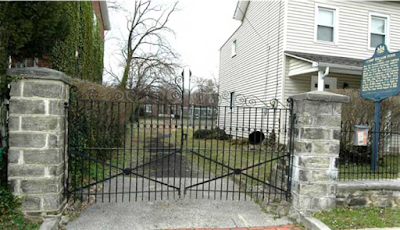Please check the June program page for info on virtual programs happening this weekend, including Pennsbury Manor's online version of their popular Brews & Bites food and beverage event. The July program page is also available, with a preview of online programs, including virtual summer camp programs at Erie Maritime Museum and the Railroad Museum of Pennsylvania. Looking for other at-home activities? Visit the Trailheads Rec Room for ideas (links are to the right of your screen).
 |
| The Manor House at Pennsbury (left) with outbuildings (photo via Facebook, credit Leah Jeffers) |
Last Friday's post shared info on numerous programs and activities scheduled to mark Juneteenth 2020. Pennsbury Manor partnered with the African American Museum of Bucks County to present an online program focused on the history of Juneteenth, the Emancipation Proclamation, and interpreting the stories of enslaved people at Pennsbury in the 17th and 18th centuries. If you missed it, the recording is available on
Pennsbury's Facebook page.
 |
| Screenshot of performer and playwright Marissa Kennedy, who explained and presented a first-person interpretation of Susannah Warder, an enslaved woman born and raised at Pennsbury during the Juneteenth virtual program. |
If you're interested in learning more about the history of slavery in colonial Pennsylvania, Graeme Park shared their research in a series of posts on Friday (first post is below - check
Graeme Park's Facebook page for the additional posts).
June is Pride Month, and recently the PA Trails of History Facebook page shared a 2019 post from the State Historic Preservation blog looking at the history of the Stonewall Uprising (last year was the 50th anniversary), the fight for LGBTQ+ rights in Pennsylvania, and several Pennsylvania sites associated with LGBTQ+ history (
read the blog post). Readers might also be interested in a new book,
Out in Central Pennsylvania: The History of an LGBTQ Community, by William Burton with Barry Loveland (our former PHMC colleague). The book was published by Penn State University Press, but check with the
LGBT Center of Central PA for a copy.
 |
| Text reads: Hidden Knowledge at Ephrata. Special thanks to Dr. Jeff Bach for his assistance in preparing this virtual exhibit (photo via Facebook) |
The staff at Ephrata Cloister have launched
Hidden Knowledge at Ephrata, a new virtual exhibit exploring the multifaceted religious world view of the Ephrata community. It includes numerous sources of knowledge and philosophy and shares their impact on the belief systems of the Conrad Beissel and those who followed him. You can find the exhibit on Ephrata Cloister's website (
link to exhibit).
As part of their deeper dives into Harmonist history, Old Economy Village staff recently shared a series of posts exploring literary figures who wrote about the Harmonists. While first debunking an old story that Charles Dickens had visited Economy during his American travels, they shared literary works and letters from Rudyard Kipling, Lord Byron, and Nikolaus Niembsch von Strehlenau (an Austrian poet). The Dickens post is below; visit
Old Economy's Facebook page to see the others.









